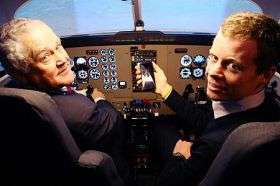Manager of professional programmes at the School of Aviation, Frank Sharp, with James McCarthy, designer of the system that is a new safety feature in training aircraft.
Pilots will no longer be out of sight as they fly cross-country thanks to a new tracking system developed by Massey University mechatronics graduate and a former staff member.
James McCarthy and Don Sandbrook developed the Spidertracks system to combat radar blackspots – areas where no radar coverage exists – meaning planes can now be located at all times.
Mr McCarthy worked with the University’s School of Aviation to trial the system in its earlier stages and now, in a significant commitment to safety, the School has bought five units.
The palm-sized Spidertracks unit picks up a global positioning systems (GPS) signal giving the plane’s position, transmits it to the Iridium satellite network and beams it down to servers in Australia and Wellington.
From there the signal travels via the web to the operations base. In real-time, the route of the craft is overlaid onto Google Earth maps. Updates on the position of the plane appear every few minutes for as long as there is a power supply to the Spidertrack unit.
School general manager Captain Ashok Poduval says buying the system is a major step in enhancing safety for any a student pilot who is lost or in difficulty due to unexpected bad weather.
The units will be used in selected aircraft as student pilots fly through parts of the country where there is no radar cover. Until now the position of the training planes flying outside of controlled airspace – much of New Zealand – would have been worked out from a flight plan submitted by the pilot, showing the intended route before departure.
Spidertracks is different from all other satellite tracking systems because Mr Sandbrook discovered a way to integrate a GPS receiver and satellite transmitter into one unit, without the need for external antennae – the first time this had been done.
Captain Poduval says the new tracking equipment also adds training value.
“The system keeps a record of all flights flown so instructors can print out details of the track flown by a student and use this for post-flight debriefing.”
Spidertracks is now used by helicopter, fixed wing and land-based operations, in more than 25 countries.
Source: Massey University
























